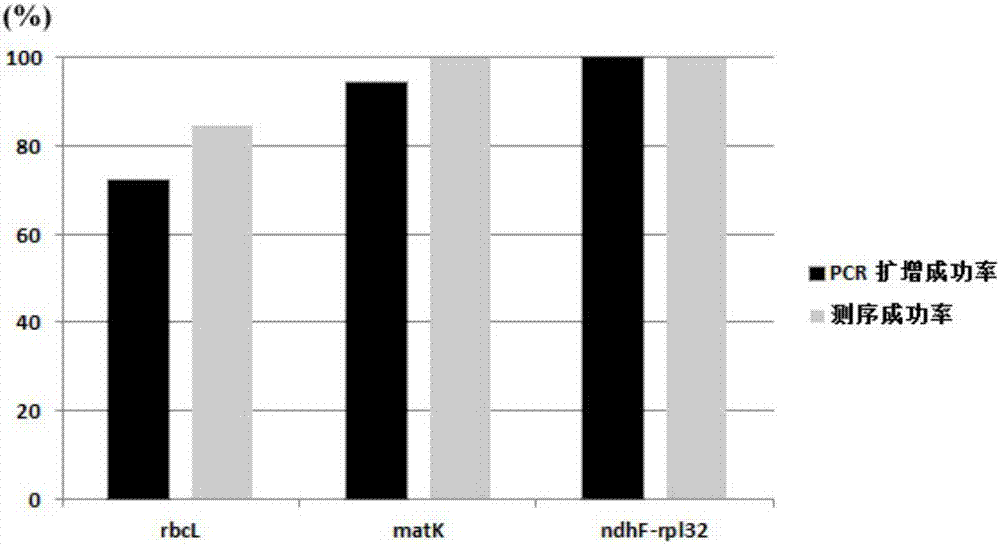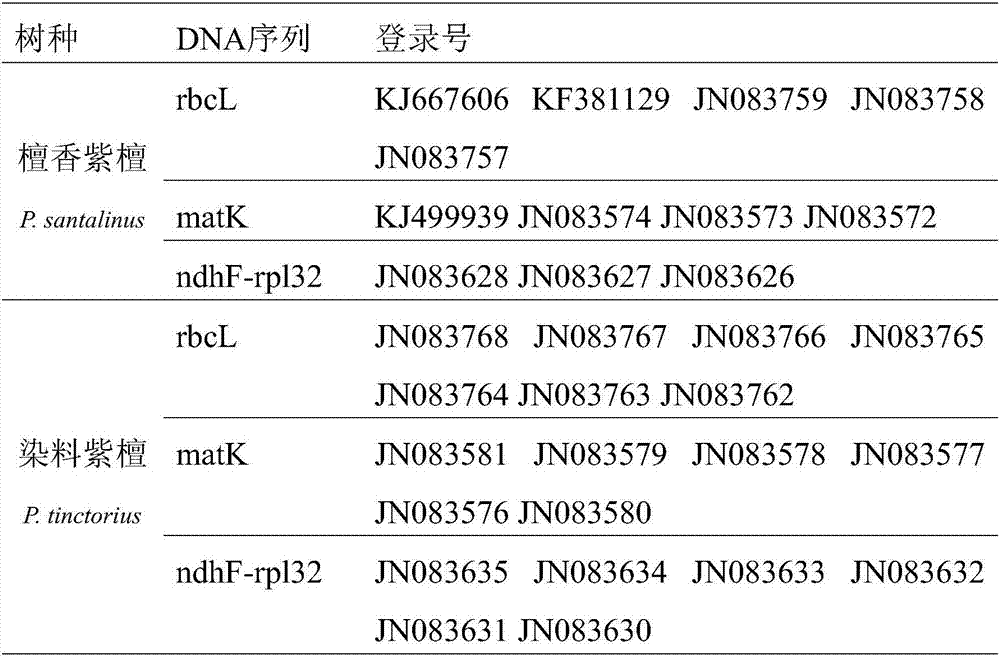Miniature DNA (deoxyribonucleic acid) bar code for identifying pterocarpus santalinus and pterocarpus tinctorius, and identifying method and application of identifying method
A technology for sandalwood and red sandalwood and dye red sandalwood, which is applied in the directions of recombinant DNA technology, biochemical equipment and methods, DNA/RNA fragments, etc., can solve problems such as inability to accurately identify sandalwood red sandalwood and dye red sandalwood, and achieves less dependence on experimental conditions, Amplification and sequencing with high success rate and good specificity
- Summary
- Abstract
- Description
- Claims
- Application Information
AI Technical Summary
Problems solved by technology
Method used
Image
Examples
Embodiment 1
[0037] Embodiment 1: Sandalwood pterocarpus and dye pterocarpus specific primer design
[0038] (1) Download the plastid DNA sequences rbcL, matK and ndhF-rpl32 (Table 1) of pterocarpus sandalwood and dye pterocarpus in GenBank;
[0039] Table 1 The accession numbers of the three DNA fragments of sandalwood and dyed pterostilbene in GenBank
[0040]
[0041] (2) Use Clustal X 1.81 software to compare the sequences, and find and determine the difference sites of the fragment sequences of the sandalwood and the dyed pterostilbene;
[0042] (3) The Primer Premier 5.0 software was used to design primers for the three barcodes of rbcL, matK and ndhF-rpl32. The amplification primers are shown in Table 2.
[0043] Table 2 Three barcode primer information
[0044]
Embodiment 2
[0045] Example 2: Selection and determination of miniature DNA barcode sequences of sandalwood rosewood and dye rosewood standard samples
[0046] (1) Standard sample collection.
[0047] The standard sample of sandalwood and red sandalwood is No. 9, of which wood specimens CAFW23674, CAFW23675, CAFW23676, and CAFW22653 of sandalwood and red sandalwood species No. 4 were selected from the Timber Herbarium of the Chinese Academy of Forestry; they were collected from Jianfengling, Ledong County, Hainan Province, China for botanical identification Sandalwood rosewood leaves No. 5, respectively TXL01, TXL02, TXL03, TXL04, TXL05. Dye standard sample No. 3 of red sandalwood, RLW01, RLW02, RLL01, respectively collected from the sapwood, heartwood and leaves of the Democratic Republic of the Congo.
[0048] (2) Sample preparation.
[0049]Select a wood sample, use a 70% alcohol-sterilized scalpel blade to cut off the outer surface of the wood sample to avoid external pollution; cut ...
Embodiment 3
[0060] Embodiment 3: Dye Pterocarpus fresh wood sample DNA identification
[0061] (1) Collection of fresh wood samples of dyed red sandalwood.
[0062] The dyed red sandalwood fresh wood sample RLW03 was collected from Katanga Province (S10°E28°) in the Democratic Republic of Congo on April 16, 2015. Observation of wood anatomy shows that the wood sample has the characteristics of rosewood wood in the national standard GB / T 18107-2000 of "Redwood", but the wood anatomy characteristics cannot distinguish whether the sample is sandalwood or dyed red sandalwood.
[0063] (2) Prepare wood flour and grind it to 200 mesh or above.
[0064] (3) Wood DNA extraction.
[0065] In a sterilized ultra-clean working environment, DNA extraction is performed on wood. The DNA still needs to be purified, and the final concentration of the DNA is 1-200 ng / μL.
[0066] (4) PCR amplification reaction and sequencing.
[0067] The wood DNA extract is used as a template for PCR amplification, a...
PUM
 Login to View More
Login to View More Abstract
Description
Claims
Application Information
 Login to View More
Login to View More - R&D
- Intellectual Property
- Life Sciences
- Materials
- Tech Scout
- Unparalleled Data Quality
- Higher Quality Content
- 60% Fewer Hallucinations
Browse by: Latest US Patents, China's latest patents, Technical Efficacy Thesaurus, Application Domain, Technology Topic, Popular Technical Reports.
© 2025 PatSnap. All rights reserved.Legal|Privacy policy|Modern Slavery Act Transparency Statement|Sitemap|About US| Contact US: help@patsnap.com



